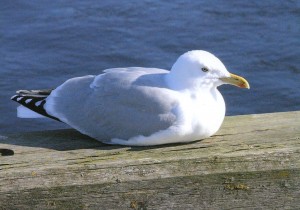 Car parks in Inverness may seem strange places to look for birds but there is range of birds to be found some of which probably spend most of the year there. The attraction is the comparatively warmer conditions there, plenty of cover and shelter and the availability of free food in various forms. Some birds seem to have a system whereby if one finds some food and people still often throw food around, the others will see and join in. The past masters to this approach seems to be the herring gulls. Some adults even bring in their young as soon as they have fledged and are able to fly. These large gulls will either walk around the area, often even sitting on the top of cars, or standing on some elevated point such as the top of buildings or lights. Once a bird swoops down for food the others see and follow suit. Crows are the same and even small birds such as blackbirds will use such methods.
Car parks in Inverness may seem strange places to look for birds but there is range of birds to be found some of which probably spend most of the year there. The attraction is the comparatively warmer conditions there, plenty of cover and shelter and the availability of free food in various forms. Some birds seem to have a system whereby if one finds some food and people still often throw food around, the others will see and join in. The past masters to this approach seems to be the herring gulls. Some adults even bring in their young as soon as they have fledged and are able to fly. These large gulls will either walk around the area, often even sitting on the top of cars, or standing on some elevated point such as the top of buildings or lights. Once a bird swoops down for food the others see and follow suit. Crows are the same and even small birds such as blackbirds will use such methods.
Last week I was sat in a busy Inverness car park with cars coming and going and a hooded crow was mainly simply scavenging for any scraps left lying around by people. The bird also went up to stationary vehicles and took insects off radiators and bumpers as well as wheels. In one corner of the car park, outside a large pet shop, the house sparrows had a different technique as a dozen or more were helping themselves to mixed grain. The bags of the seed were in piles outside the shop and when the bags were moved occasionally a bag would split and the house sparrows had a field day. There used to be several house sparrows actually in this particulalr pet store but presumable they were moved in some way on health grounds. In another large store I looked in last year some starlings took a different approach. On the section where the garden bird food was sold there were suet balls and mixed seed feeders hanging up on display and six starlings were helping themselves, actually inside the large store. The birds completely ignored shoppers passing within a few feet of them.
The crows in car parks look almost arrogant as they strut around no doubt feeling quite safe and getting very used to such surroundings. Elsewhere in the Highlands no other bird has been so relentlessly pursued in attempts to curb its numbers and distribution. There are even traps, the now famous Larsen traps, that were designed with these birds in mind. Despite such levels of persecution the crows still seem quite common. In Inverness there appears to be two different types of crows, one of which is the hooded crow with its typical grey and black plumage as shown in the photograph. At the other extreme is the carrion crow and this is more or less black all over. The two birds used to be classed as different species although commonly known to interbreed and the offspring were fertile and the result was a mixture of the two forms. Then after further studies it was decided, in 2002 , that they were in fact two separate species. Interestingly if you go to Aberdeen you will mainly only see the all black carrion crows whilst on the west coast it is mainly the hooded crows. In the middle of these two ranges is the hybrid zone where you can see birds showing variation in their plumage. This zone happens to run north to south through the eastern Highlands including Inverness which is why we get both species in the car parks.
